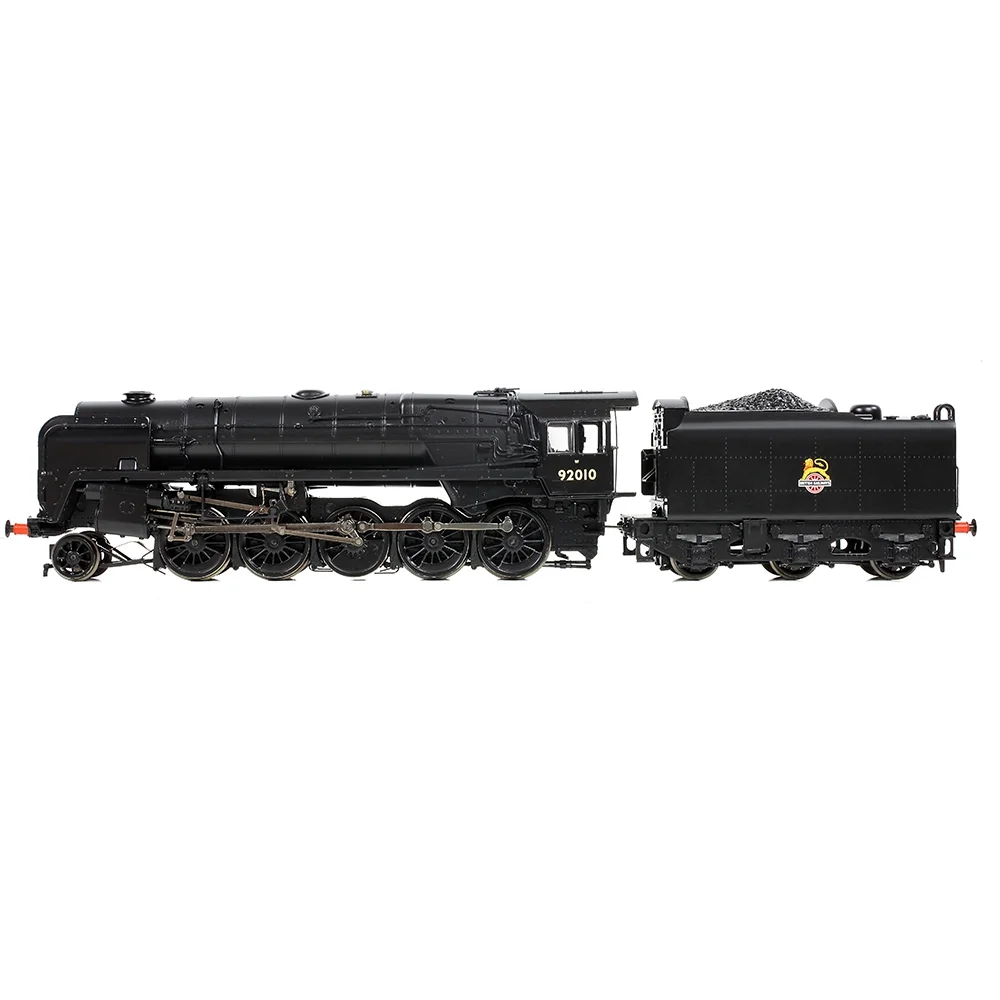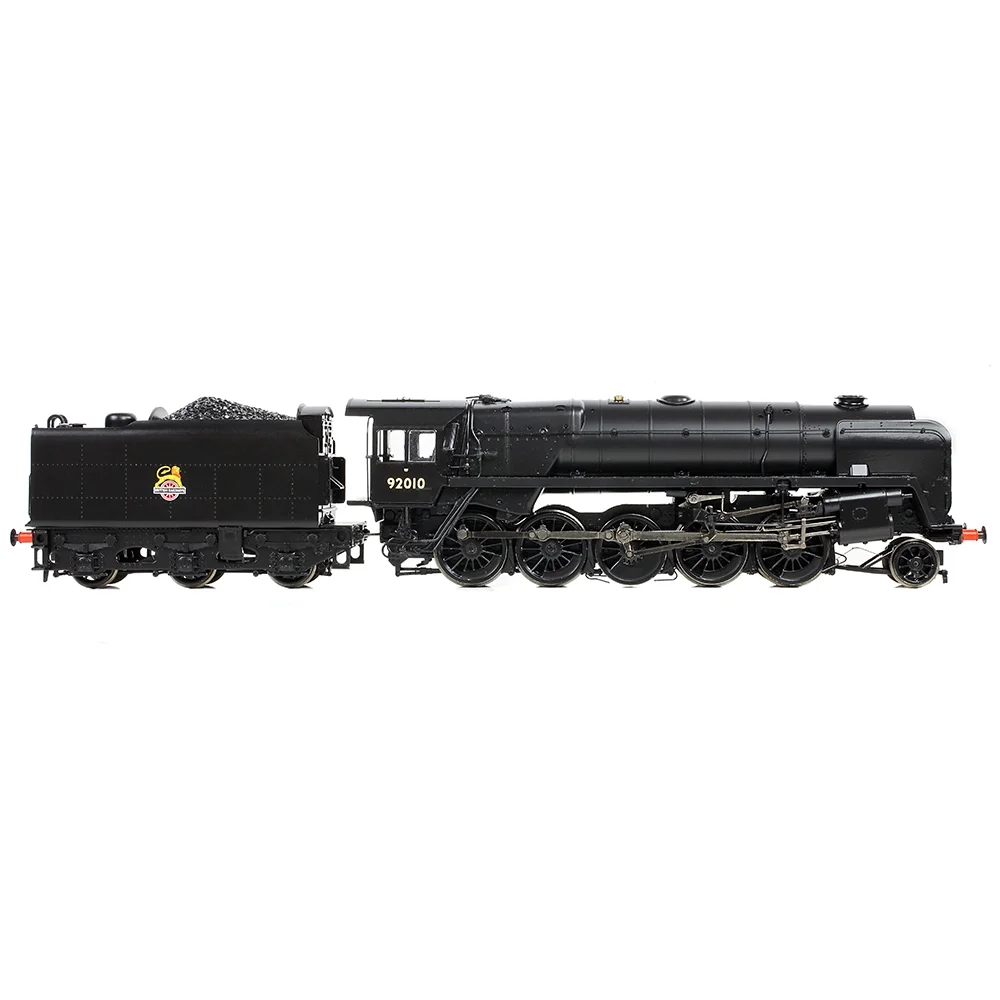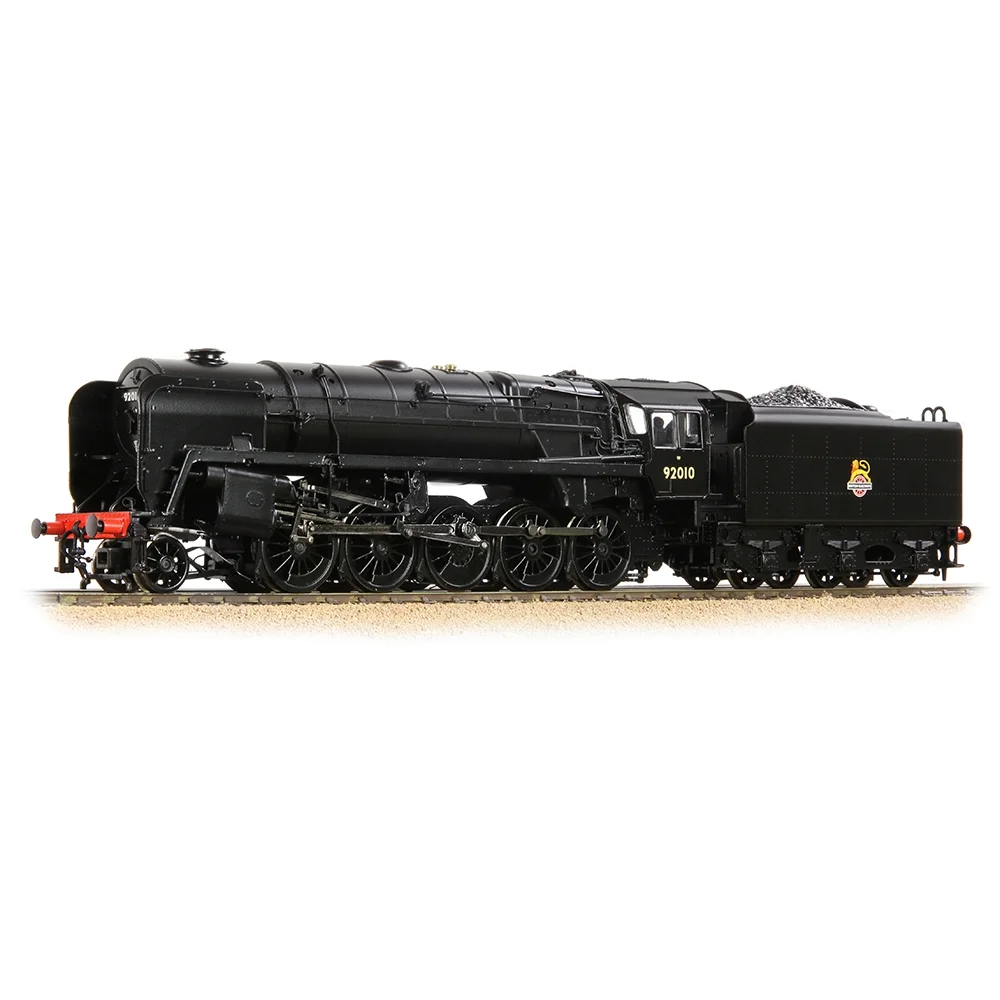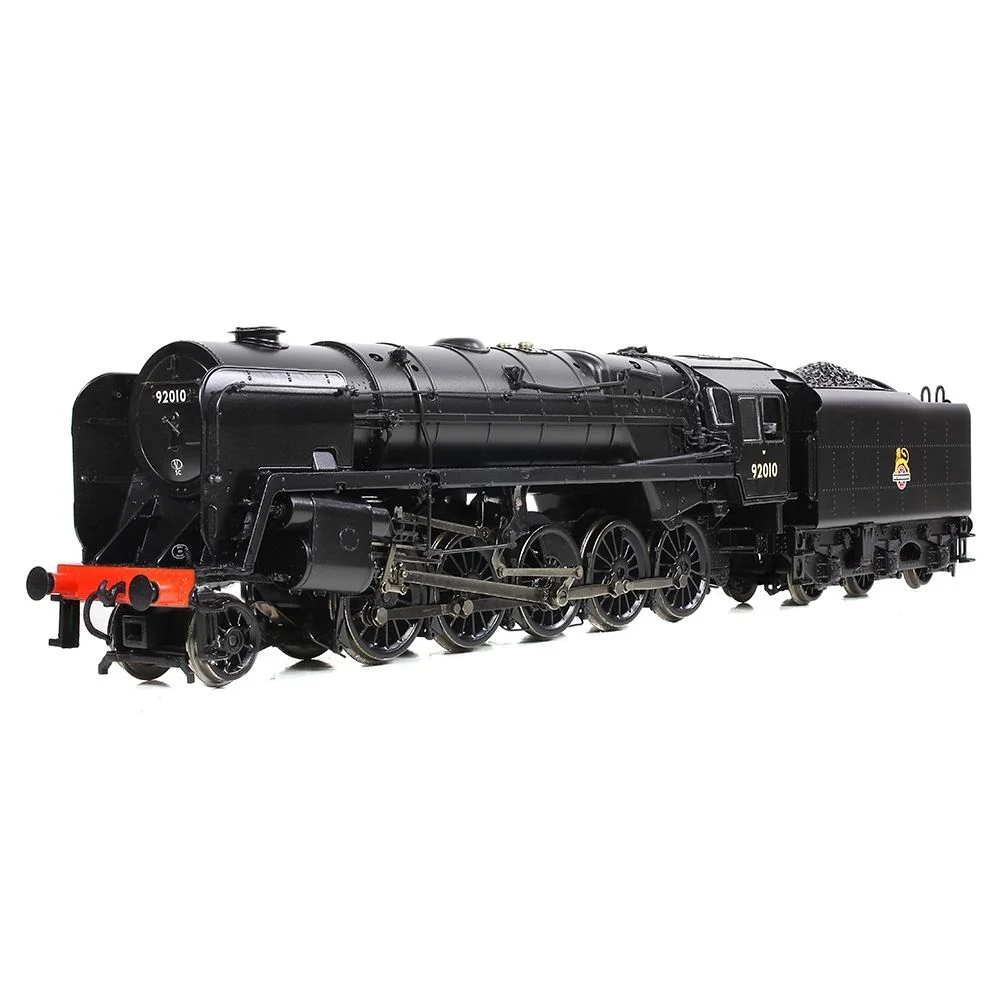Bachmann 32-852BSF
British Railways Standard Class 9F 92010 British Railways Black with Early Emblem
Tooling
In late 2022, Bachmann Europe introduced an upgraded tooling for its Branchline Standard Class 9F model in OO gauge. This update marked a significant enhancement over the original 2006 tooling, with improved detailing, built-in sound capability, and accurately modelled variants including the distinctive "Tyne Dock" Westinghouse-pump-equipped locomotives.
Tooling Features & Detailing
- Shell & Bodyside Detail: Refinements include updated running plate cut-aways for pumps and revised underbody pipework to accurately depict pump-fitted locomotives like the Tyne Dock batch.
- Chassis Construction: Plastic and metal build retained, with enhancements in separate fittings—cab lamps, brake pipes, detailed bufferbeams, authentic brake rigging and chemically blackened motion work.
- Couplings & Tender: Features NEM pocket tension-lock couplings and sprung buffers. The tender offers an adjustable drawbar with dual positioning for accurate coupling distance.
Mechanical & Electrical
- Drive & Motor: Still powered by a robust 5-pole motor, driving four wheels with built-in chassis weight for excellent traction.
- Pickups: Electrical pickup now extends through tender wheels, enhancing slow-speed running and curb curve performance.
- Minimum Radius: Operates comfortably on R2 curves, benefitting from improved underframe clearance and pickups on tender.
- Weight & Running: Overall weight remains substantial; driver feedback notes smooth and strong pulling under heavy load.
DCC & Sound Integration
- Onboard DCC Socket: PluX22 socket pre-installed, facilitating easy insertion of any suitable decoder.
- Factory-Fitted Speaker: A major upgrade—onboard speaker allows genuine out-of-box sound.
- Sound-fitted Versions: Many releases include ESU Loksound V5 decoders with Westinghouse pump, boiler chuffs, injectors, whistle, coupling clank, and other multi-function effects.
Liveries & Variants
- Tyne Dock Editions: Featuring detailed moulding and pipework for Westinghouse pumps; typically in heavy-weathered black, representing ore transport to Consett.
- Other Releases: Include BR Black early/late crest locomotives, single- and double-chimney versions, all released in both plain and heavily-weathered finishes with optional sound-fitted or standard versions.
Reception & Community Feedback
- Detailing: Broadly praised, particularly the refined running plate, accurate pumps and fresh paint & weathering work.
- Sound & Running: Sound-fitted models receive acclaim for their rich function set and strong motor performance.
- Curve Performance: Improved pickups and underframe detail address earlier issues on tighter curves, though some modders still fit guide wheels or stay-alive capacitors for perfect operation.
Media & Social Commentary
- RMweb and club forums highlight the quality of Westinghouse pump modelling and sound calibration, often backed by comparative layout and running videos.
- Railways press coverage in Bachmann’s Autumn 2023 announcement emphasises the tooling’s accuracy, onboard speaker, and Tyne Dock option as key enhancements.
- YouTube comparison videos show the improved moulding compared to earlier tooling and rival Hornby variants, especially in tank and pump details.
Additional Notes
- Still mechanically based on the original 5-pole motor and drivetrain architecture, but with incremental refinements enhancing performance and sound capability.
- All models retain removable coal load and two-setting drawbar, with tender weight and pickups delivering improved tracking and gradual deceleration.
- The tooling remains in current production, forming the basis for future variants and liveries through to the next-generation release.
Bachmann's Description & Specifications
The Bachmann Branchline OO scale BR Standard Class 9F locomotive is an imposing model and with its high fidelity, exquisite detailing and powerful performance, it is no wonder this is an Award Winning model. With an impressive weight and a presence befitting the strongest of BR’s standard steam locomotive classes, the Branchline 9F is a fine choice to haul prototypical trains on your model railway. Now updated to feature a Plux22 DCC decoder socket and pre-fitted speaker, you can easily fit sound to this model or, choose our SOUND FITTED model to enjoy sound straight from the box.
As part of our Winter 2022 British Railway Announcements, we are delighted to present the BR Standard Class 9F as No. 92010 in BR Black livery with Early Emblem. Featuring a single chimney and coupled to a BR1F tender, this model is supplied complete with SOUND FITTED.
MODEL FEATURES:
- Bachmann Branchline OO Scale
- Era 4
- Pristine BR Black (Early Emblem) livery
- Running No. 92010
- Coupled to a BR1F Tender
- Single Chimney
- Removable Coal Load with coal space modelled below
- Adjustable Tender Drawbar (two settings)
- Accessory Pack
- NEM Coupling Pockets
- Sprung Buffers
- Powerful 5 Pole Motor
- SOUND FITTED - Fitted with a ESU Loksound V5DDC Sound Decoder
- Length 275mm
Class & Prototype
- Class: British Railways Standard Class 9F
- Traction: Steam
- Built: 1954-1960
- Total Built: 251
- Running Number: 92010
Operator & Livery
- Operator: British Railways
- Livery: Black with Early Emblem
- Era: 4 - British Railways Early Emblem
British Railways transformed Britain's fragmented rail network into a unified national system following nationalisation on 1st January 1948. Created from the "Big Four" companies under the Transport Act 1947, BR operated most of Great Britain's railways until rebranding as British Rail in 1965, managing over 20,000 route miles and inheriting nearly 20,000 locomotives of diverse designs.
The organisation pioneered standardisation through its revolutionary BR Standard locomotive programme (1951-1960), producing 999 advanced steam engines under Robert Riddles' direction. These included the versatile Britannia Pacifics, mighty 9F freight engines, and mixed-traffic classes that incorporated the best features from all predecessor companies. The 1955 Modernisation Plan accelerated diesel and electric traction development, creating fascinating mixed-traction operations.
Notable achievements included establishing unified locomotive classification systems, introducing distinctive corporate liveries, and managing the complex transition from steam to modern traction. BR's six regional structure preserved operational diversity whilst enabling standardisation of practices, signalling, and rolling stock that had eluded private enterprise for over a century.
The BR era represents steam traction's final flowering alongside emerging diesel technology, creating unparalleled locomotive variety. Today, this heritage remains highly popular with railway enthusiasts through extensive preserved fleets, heritage railway operations, and comprehensive model ranges from manufacturers like Hornby, Bachmann, and Dapol, making BR subjects essential for authentic post-war British railway modelling across all scales.
British Railways' plain black livery was designated specifically for freight and shunting locomotives from 1948, representing the most economical and practical finish for inherently dirty industrial machines. During the early nationalisation period, many locomotives were simply patch-painted over old company markings with black paint, which quickly weathered to match the existing finish as these engines were rarely cleaned. The "Lion and Wheel" emblem (nicknamed the "Cycling Lion") was introduced from December 1948 and applied to plain black locomotives from early 1949, featuring a lion standing over a large railway wheel with "British Railways" lettering across the centre.
The emblem was produced in three sizes and always faced forward, positioned centrally on tender sides or tank sides, with regional preferences evident—the Western Region favoured larger emblems whilst other regions used smaller versions. Plain black locomotives retained red buffer beams and received white "BRITISH RAILWAYS" lettering in Gill Sans style before the emblem's introduction. Some former company locomotives, particularly ex-GWR shunting engines, retained their original lettering well into the early 1960s as they didn't require renumbering and received minimal attention. This utilitarian livery remained standard for freight operations until the mid-1950s emblem change, making it essential for authentic early BR period modelling of goods yards, collieries, and industrial operations.





